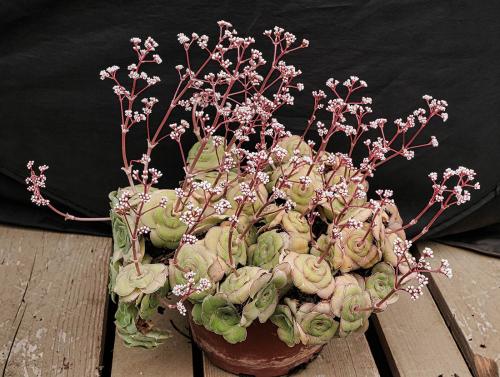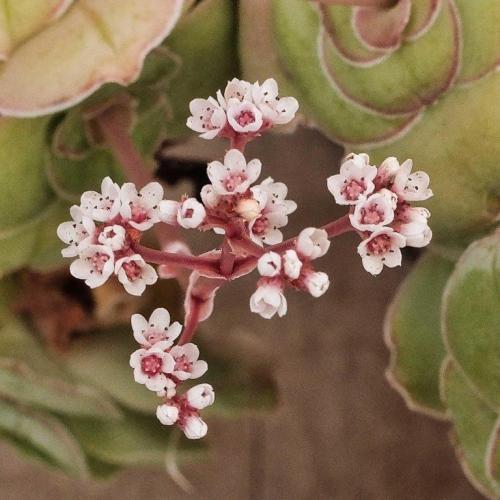INTERMEDIA Schönland, 1929 (engl./ fr.)
Section Rosulares
Distribution : SA (Eastern Cape); in shade of thickets, spring-flowering.
Description (according to Tölken, 1985) :
Perennials up to 20 cm high when flowering, with few to many rosettes with 4-ranked leaves very closely adpressed to each other.
Leaves obovate to orbicular, (8-) 10 - 30 x 10 - 30 mm, with rounded apices but usually mucronate, dorsiventrally flattened, scarcely fleshy, glabrous except for a dense row of recurved cilia, green to dark green, old leaves remaining attached to stems.
Inflorescence an elongate to round-topped thyrse with one to many dichasia each forming a dense cluster of sessile flowers, with distinct peduncle 4 - 15 cm long.
Flowers : Sepals ovate, 1 - 1.5 mm long, with rounded apices, glabrous except for long spreading cilia, scarcely fleshy, green tinged red or brown, corolla tubular, fused basally for 0.2 - 0.4 mm, white often tinged red, petals obovate or oblong-obovate, 2 - 2.5 mm long, with rounded apices, erect and usually scarcely recurved, anthers yellow.
Note :
1. Tölken wrote (p. 332, 1977) :"The leaves of this species are closely adpressed to one another and recurved under dry conditions and when the plants are young, whereas they are erect and forming a cup-shaped rosette under humid conditions and also when the plant is flowering" - see the first photo below.
2. C. intermedia is similar to C. socialis and C. montana ssp. quadrangularis. Tölken wrote (p. 333, 1977) : “Diagnostic Features: Plants of C. socialis are often so similar to C. montana subsp. quadrangularis that they can only be distinguished by the very short and reflexed style of the former. C. socialis has this unique character in common with C. intermedia, but the latter is distinguished by its much larger rounded leaves which are hardly fleshy and either reflexed or erect but always adpressed to one another. Also, C. socialis produces a rounded inflorescence with lateral dichasia from not more than two nodes, while C. intermedia produces an elongate inflorescence with 3 - 5 pairs of lateral dichasia branching from the central axis.” And p. 167, 1985: “The reflexed style is typical of C. socialis and C. intermedia [see photo 3 below]. . . and is found nowhere else in the genus, but the latter is always easily distinguished by its larger plants and flowers and by its longer inflorescences which bear 3-5 pairs of lateral part-inflorescences.”
----------------------------------------------------------------------------------------------------------------
Section Rosulares
Distribution : Afrique du Sud (Cap-Oriental) ; à l'ombre des fourrés, floraison printanière.
Description (selon Tölken, 1985) :
Plante vivace atteignant 20 cm de haut lors de la floraison, avec peu à beaucoup de rosettes composées de feuilles en 4 rangées bien empilées les unes sur les autres.
Feuilles obovales à orbiculaires, (8-) 10 - 30 x 10 - 30 mm, à l'apex arrondi mais habituellement mucroné, aplaties, à peine charnues, glabres à l'exception d'une dense rangée de cils marginaux, vertes à vert foncé, les anciennes feuilles restant attachées à la tige.
Inflorescence : Un thyrse allongé ou à tête ronde, avec un à plusieurs dichasia, chacun formant un dense bouquet de fleurs sessiles, pédoncule bien visible long de 4 - 15 cm.
Fleurs : Sépales ovales, 1 - 1,5 mm de long, à l'apex arrondi, glabres à l'exception de longs cils étalés, à peine charnus, verts et teintés de rouge ou de marron, corolle tubulaire, soudée en bas sur 0,2 - 0,4 mm, blanche teintée de rouge, pétales obovaux ou oblongs-obovaux, 2 - 2,5 mm de long, avec extrémité arrondie, dressée et habituellement légèrement recourbée, anthères jaunes.
At left Crassula intermedia in bud at mid-March and post flowering in mid-August: :
.jpg)
Crassula intermedia Botanical Wonders Nursery in Vista, California :

Close-up showing the reflexed styles mentioned by Tölken, typical for Crassula intermedia and C. socialis :

Photos Jim A. Bartel